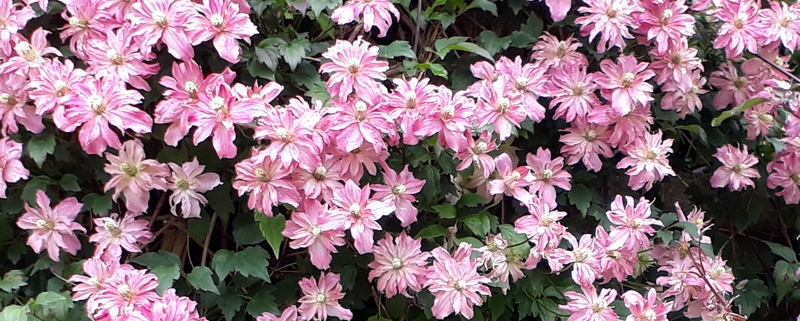Climbing plants for cover
I am regularly asked for plant suggestions to break up the bulk of a fence or wall, soften the outlook and give colour without spilling out over the lawn or occupying all the space in a border. That is quite an ask of a plant!

But happily there is an answer: Climbers. Plants that can be trained in 2 dimensions to hug the fence and cover a substantial vertical area for a very small footprint. Choosing one with coloured leaves or flowers adds extra sparkle and including at least one evergreen climber ensures that winter is also (literally) covered and insects have a snug spot to hibernate.
There are a few well known plants that use aerial roots or suckers to attach themselves to the supporting structure – Ivy and Virginia Creeper being two – but I generally recommend using non-clinging climbers especially on the wall of a building and where soffits, gutters or tiles are involved.
To support climbers that do not attach themselves, screw vine eyes into the fence posts or into the wall at similar intervals and stretch galvanised wire across. Horizontal wires with a vertical distance of 60cm between will be enough for most plants. New plants will need to be trained up to the first wire with a cane and gently tied in. After that it depends on the plant. Roses are scramblers and wild roses use their thorns to hook onto the stems of supporting shrubs. When trained onto a fence, they need to be tied onto the wires whilst the stems are flexible in late summer. Contrastingly Clematis twirl their leaf stalks around anything that touches and will be self sufficient on the wires once established. Honeysuckle twines the whole stem around a support and in extreme cases can strangle woody shrubs or climbers growing alongside. Trachelospermum is a useful, evergreen, flowering climber that has fairly stiff stems and will also make its own way up a trellis or wires.
The key to successful climbers is to understand how and when to prune to fill the space without overwhelming the neighbours and stick close to the wall.
Happy Gardening from Alison
If you enjoyed reading this blog why not receive my monthly newsletter direct to your email inbox with blogs, video tips and seasonal articles to inspire and inform. Sign up HERE.

